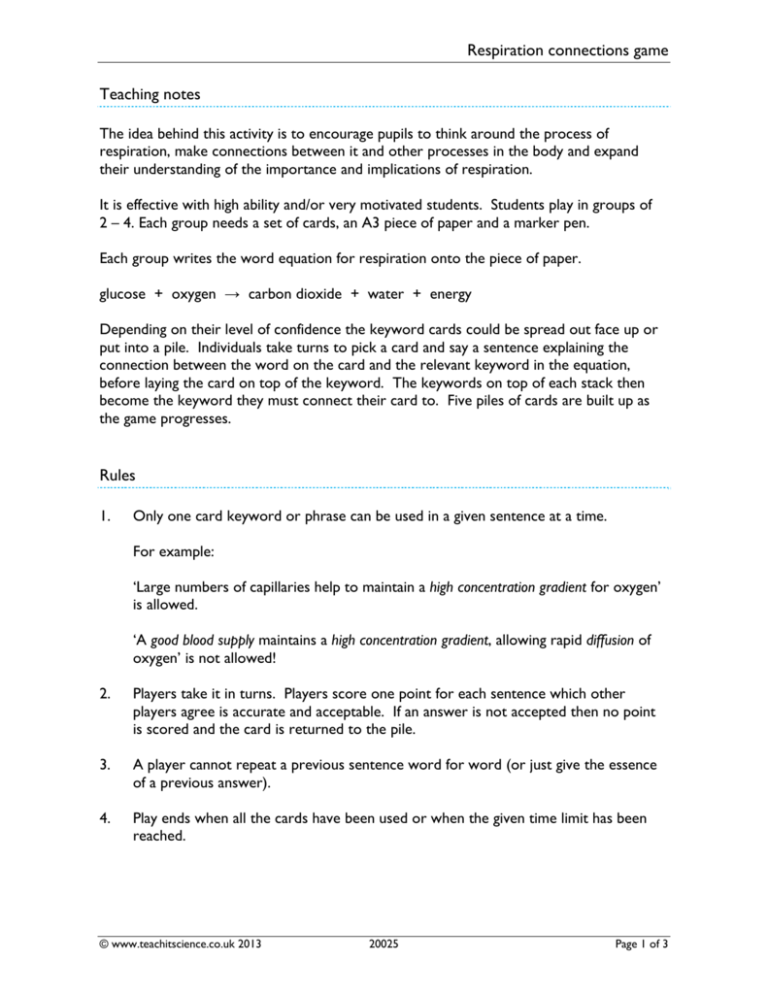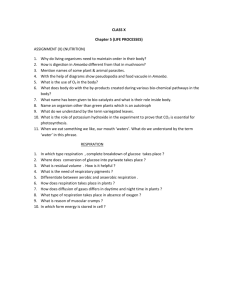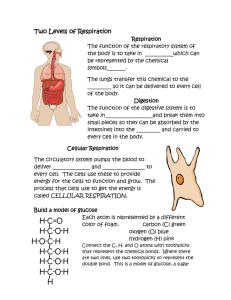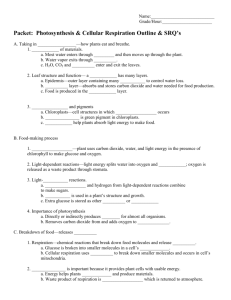Respiration connections game Teaching notes Rules
advertisement

Respiration connections game Teaching notes The idea behind this activity is to encourage pupils to think around the process of respiration, make connections between it and other processes in the body and expand their understanding of the importance and implications of respiration. It is effective with high ability and/or very motivated students. Students play in groups of 2 – 4. Each group needs a set of cards, an A3 piece of paper and a marker pen. Each group writes the word equation for respiration onto the piece of paper. glucose + oxygen → carbon dioxide + water + energy Depending on their level of confidence the keyword cards could be spread out face up or put into a pile. Individuals take turns to pick a card and say a sentence explaining the connection between the word on the card and the relevant keyword in the equation, before laying the card on top of the keyword. The keywords on top of each stack then become the keyword they must connect their card to. Five piles of cards are built up as the game progresses. Rules 1. Only one card keyword or phrase can be used in a given sentence at a time. For example: ‘Large numbers of capillaries help to maintain a high concentration gradient for oxygen’ is allowed. ‘A good blood supply maintains a high concentration gradient, allowing rapid diffusion of oxygen’ is not allowed! 2. Players take it in turns. Players score one point for each sentence which other players agree is accurate and acceptable. If an answer is not accepted then no point is scored and the card is returned to the pile. 3. A player cannot repeat a previous sentence word for word (or just give the essence of a previous answer). 4. Play ends when all the cards have been used or when the given time limit has been reached. © www.teachitscience.co.uk 2013 20025 Page 1 of 3 Respiration connections game Suggested variations 1. Players can not go back a step in a sequence but they can begin a new sequence, or choose a card which has no follow on. E.g. ‘Glucose molecules are absorbed by villi in the small intestine’, followed by, ‘the digestion of carbohydrates begins in the mouth’, is not allowed. 2. It could be stipulated that each sentence must include the keyword from the word equation which forms the base of the stack. E.g. ‘Glucose is transported in blood plasma’ ‘The enzyme amylase breaks down large carbohydrate molecules into small glucose molecules’ ‘Some glucose is stored in the liver’ 3. Play could focus on one part of the word equation at a time. Use the Teachit Timer to signal a change of focus to another part of the equation. 4. After the first couple of games, players could decide who in their group was the most eloquent, the most accurate, the loudest/quietest, most succinct and new teams created from these individuals. Extension activities Teams share sentences which they are most proud of with the rest of the class for further discussion. Students build up a mind map around the equation by sticking down the keyword cards, adding notes and arrows. Students list which organ systems are connected to respiration. Teams design their own cards for ‘respiration in plants’ or for ‘photosynthesis’. © www.teachitscience.co.uk 2013 20025 Page 2 of 3 Respiration connections game breathing rate homeostasis alveoli isotonic concentration gradient starch good blood supply exhaled air oxyhaemoglobin glycogen inhalation colon large surface area red blood cells liver diffusion isotonic kidneys photosynthesis heart rate hypoglycaemic dissolves oxygen debt dissolves lactic acid anaerobic absorbed insulin plasma mitochondria mouth exercise amylase © www.teachitscience.co.uk 2013 20025 Page 3 of 3







